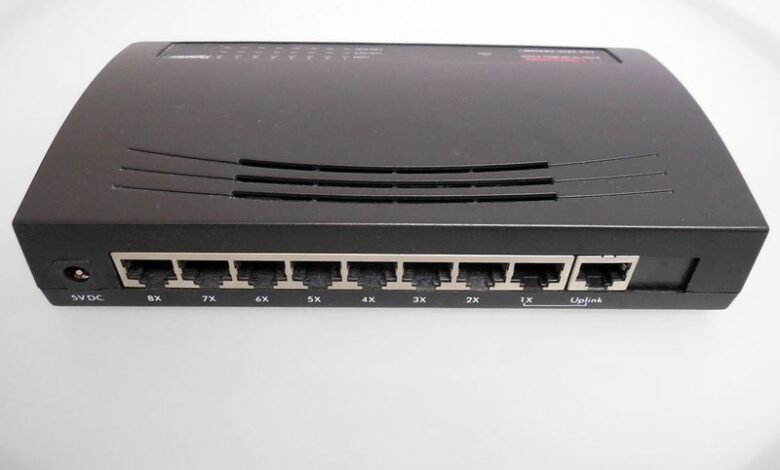7 Common Router Issues (and How to Fix Them)

If you’re like most normal people, the internet is a confusing topic. All you know is that the internet allows you to search for different things online. But, when you’re facing Wi-Fi problems, it couldn’t hurt to learn how the internet works.
One of the most fundamental devices for setting up an internet connection is a router. This means if your Wi-Fi is acting up, your router is the likely culprit. In this article, we’ll discuss seven of the most common router issues and how to fix them.
But first, we’ll explain everything you need to know about a router to make troubleshooting easier.
What is a Router?
A router is simply a device that connects your computer to the internet. It does this by using an Ethernet cable to connect to your modem, which then allows you to access the internet wirelessly.
Most routers have four Ethernet ports, which means they can connect to up to four devices at a time. If you want to connect more than four devices, you can use a router with more ports or buy a separate switch.
How Does a Router Work?
Now that you know what a router is, let’s discuss how it works. As we mentioned before, a router connects to your modem via an Ethernet cable. Once it’s connected, the router creates a Wi-Fi network that your devices can connect to.
The router also assigns IP addresses to each device on the network. An IP address is simply a numeric label that helps identify each device on a network.
Most routers use something called DHCP to automatically assign IP addresses to devices. However, you can also manually set up an IP address if you want more control over your network.
What are the Different Types of Routers?
Computers can connect to the internet in many different ways. Thus, there are many different routers to choose from. The type of router you need depends on your internet connection and the number of devices you want to connect.
The first type is wireless routers. These are the most common type of routers. They use Wi-Fi to connect wirelessly to your devices. The second type is wired routers. These routers use Ethernet cables to connect to your devices. They’re typically used in businesses or homes with a lot of devices.
The final type is modem router combos. These devices combine a modem and router into one unit. They’re usually used by people who have cable or DSL internet service.
What’s the Difference Between a Router and a Modem?
You might be wondering what the difference is between a router and a modem. A router connects your devices to the internet, while a modem connects your router to the internet.
Modems come in two different types: cable modems and DSL modems. Cable modems are used with cable internet service, while DSL modems are used with DSL internet service.
Why Do You Need a Router?
You might be wondering why you need a router if you already have a modem. The answer is that most modems don’t have Wi-Fi, which means they can’t wirelessly connect to your devices.
Routers also provide better security for your network and give you more control over how your devices connect to the internet.
What Are Signs Your Router isn’t Working?
There are a few signs that your router isn’t working properly. The first is that your devices can’t connect to the internet. This could be because the router is turned off, the Ethernet cable isn’t plugged in, or the router isn’t getting power.
Another sign is that your router’s lights are off or blinking. Each router has different light patterns that indicate different things. If you’re not sure what the lights on your router mean, consult your router’s manual.
You might also notice that your internet connection is slow or unreliable. This could be because of interference from other devices, a weak Wi-Fi signal, or outdated router firmware.
Why Do Routers Malfunction?
One of the most common router issues is a slow internet connection. If you’re experiencing a slow internet connection, the first thing you should do is check for interference. Interference can come from things like baby monitors, microwaves, and even cordless phones. If you find that there’s interference, try moving your router to a different location.
Another common issue is frequent disconnections. This can be caused by anything from power surges to bad cables. If you’re experiencing frequent disconnections, the first thing you should do is check your router’s cables. Make sure they’re firmly plugged in and not damaged.
If your router’s cables are fine, the next step is to check for a power issue. Power surges can sometimes cause routers to malfunction. To fix this, unplug your router and plug it back in.
The final common issue is outdated firmware. Firmware is the software that runs on your router. It’s important to update router firmware because it can often fix bugs and improve performance.
These are the most basic router issues. Below, we’ll get into greater detail about other router issues you may be facing and how to fix them.
7 Common Router Issues and How to Fix Them
Again, we’ve already gone over some basic router issues and troubleshooting techniques? But, what if your problem is more advanced or specific? Here are seven of the most common router issues and how to fix them.
1. Your Wi-Fi Security Settings are Mismatched
This issue occurs when your router’s security settings are mismatched. This can happen if you’re using different types of devices or if you’ve changed your router’s settings.
To fix this issue, log into your router and check your security settings. Make sure they’re all the same. If they’re not, change them so they match.
2. You Forgot Your Router Password
If you forgot your router password, don’t worry. You can usually reset it by pressing the reset button on the back of your router.
If that doesn’t work, you can also try logging into your router’s web interface and changing the password from there.
3. Your Router is Overheating
This is a common problem with routers. If your router is overheating, it’s usually because it’s in a bad location or it’s been on for too long.
To fix this issue, try moving your router to a different location. If that doesn’t work, try restarting your router.
4. You’re Getting Interference from Other Devices
As we mentioned before, interference can be a problem for routers. If you’re getting interference from other devices, the best thing you can do is move your router to a different location.
If that doesn’t work, you can also try changing the channel that your router is using. To do this, log into your router and look for the “channel” setting. Change it to a different number and see if that helps.
5. You’re Experiencing MAC Address Restrictions
MAC address restrictions are often put in place by router manufacturers. This can be a problem if you’re trying to connect a new device to your router.
To fix this issue, log into your router and look for the MAC address restriction setting. Once you find it, disable it and try connecting your device again.
6. You Have Port Forwarding Issues
Port forwarding is a technique that allows you to forward traffic from one port on your router to another port on another device. This can be useful if you’re trying to run a server or host a website.
However, it can also be a source of problems. If you’re having issues with port forwarding, the best thing you can do is check your router’s documentation.
7. There are Loose or Disconnected Cables
As we mentioned before, loose or disconnected cables are one of the most common router issues. If you’re experiencing problems with your router, the first thing you should do is check the cables.
Make sure they’re all plugged in securely and that there’s no damage to them. If everything looks good, try restarting your router.
How to Make a Router More Secure
Now that we’ve gone over some of the most common router issues, let’s explain how you can make your router more secure.
The first thing you should do is change the default password. Router manufacturers usually use very weak passwords, so it’s important to change it to something stronger.
You should also consider enabling encryption on your router. This will make it more difficult for people to intercept your traffic and steal your data.
Finally, you should keep your router’s firmware up to date. As we mentioned before, firmware updates can often fix bugs and improve security.
When Should You Ask for Help?
If you’ve tried the troubleshooting tips above and you’re still having router issues, it might be time to ask for help. The best place to start is with your router’s manufacturer.
They should be able to help you troubleshoot the issue and get your router up and running again. You should also consider contacting your internet service provider (ISP) for help. They might be able to provide you with a new router or help you fix the issue.
How Can an IT Company Help Repair Router Issues?
If you’re still having router issues, an IT company can help. They have the tools and expertise to troubleshoot router issues and repair your internet network.
They can also help you prevent router issues in the future with regular maintenance and updates.
When Should You Buy a New Router?
If you’re experiencing router issues on a regular basis, it might be time to buy a new router. A new router can provide you with better performance and more features.
It can also help you avoid router issues in the future. Before buying a router, make sure you speak to an IT company about how to get internet network installation.
Important Router Buying Tips to Consider
If your router is beyond repair and you’re in the market for a new one, you can rest easy knowing that the buying process is a simple one. Here are some helpful tips for getting started.
Always Check Online Reviews
Before you buy a new router, you should see if particular products live up to their hype. One of the best ways to do this is by reading online reviews.
This will help you get an idea of what other people think about the router and if there are any common issues.
Assess Your Needs First
It’s also important to assess your needs before you buy a router. This will help you narrow down your options and find the perfect router for your home or office.
Some things you should consider include the size of your home, the number of devices you’ll be connecting, and what type of activity you’ll be doing online.
Choose the Right Frequency Band
When buying a new router, one of the most important things to consider is the frequency band. The two most common options are dual-band and tri-band routers.
Dual-band routers operate on both the 2.4 gigahertz and five gigahertz frequencies while tri-band routers add an additional five gigahertz frequencies.
Make Sure the Router is Compatible with Your ISP
Another important thing to consider when buying a router is compatibility. You’ll need to make sure the router you choose is compatible with your internet service provider (ISP). If it’s not, you might not be able to get the speeds you’re paying for.
Look for a Router with Advanced Features
When shopping for a new router, look for one that has advanced features like parental controls and guest networking. These features can help you keep your network safe and secure.
Prioritize Newer Wireless Protocols
When you’re looking at router specifications, you’ll see a lot of different numbers and letters. These indicate the wireless protocols the router is compatible with.
You should prioritize newer protocols like Wi-Fi 6 and WPA three when choosing a new router. This offers the best performance and security.
Learn More About Internet Technology
Routers can be tricky to deal with if you’re new to the field of internet technology. The good news is that troubleshooting most router issues only takes a few minutes or a call to the product’s technical support team.
With that said, do you want to learn more about internet technology? If so, check out our blog for more articles.








